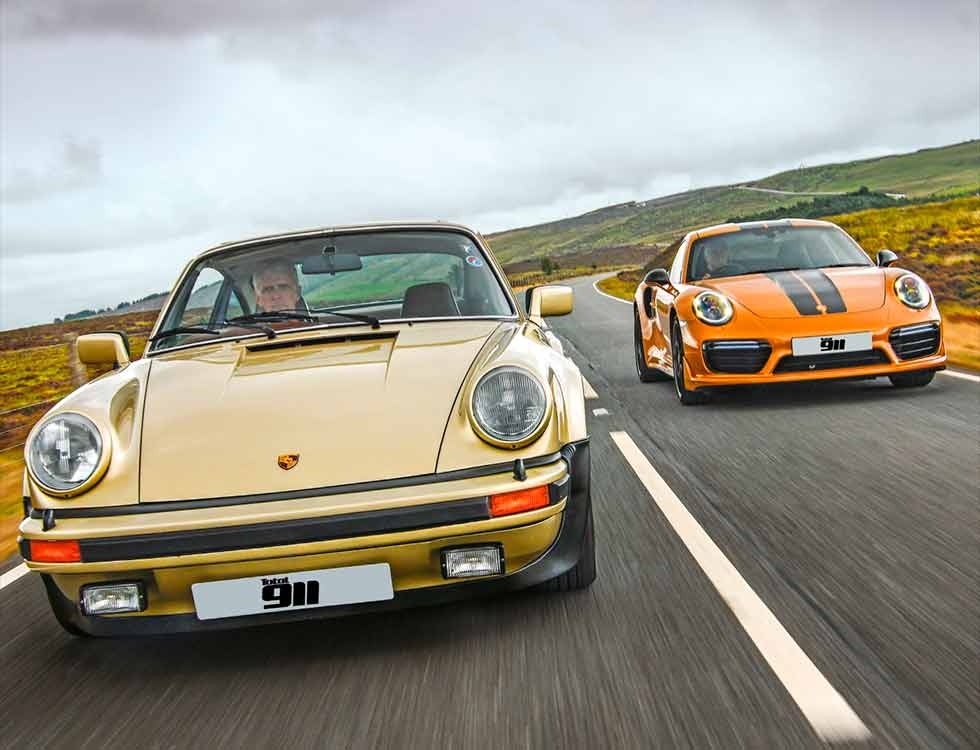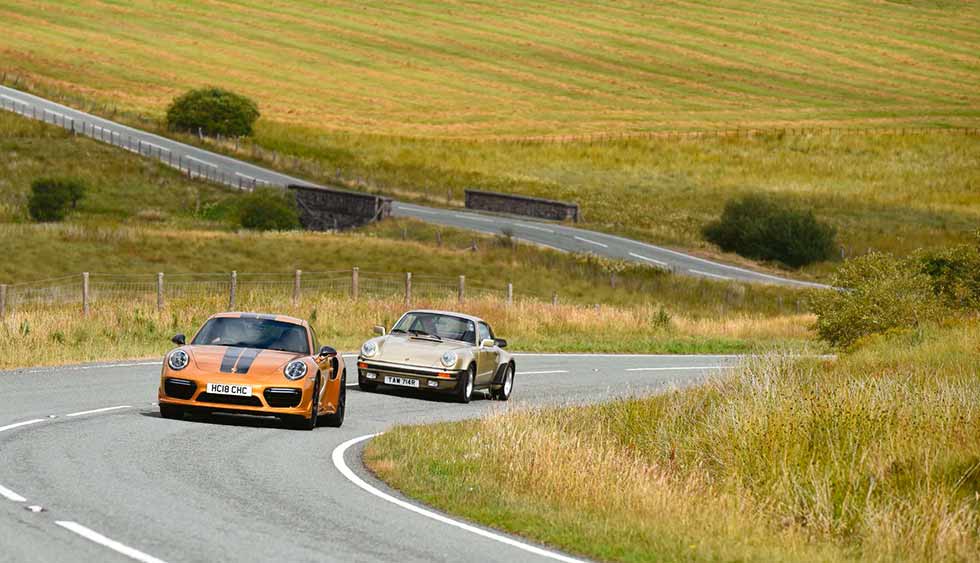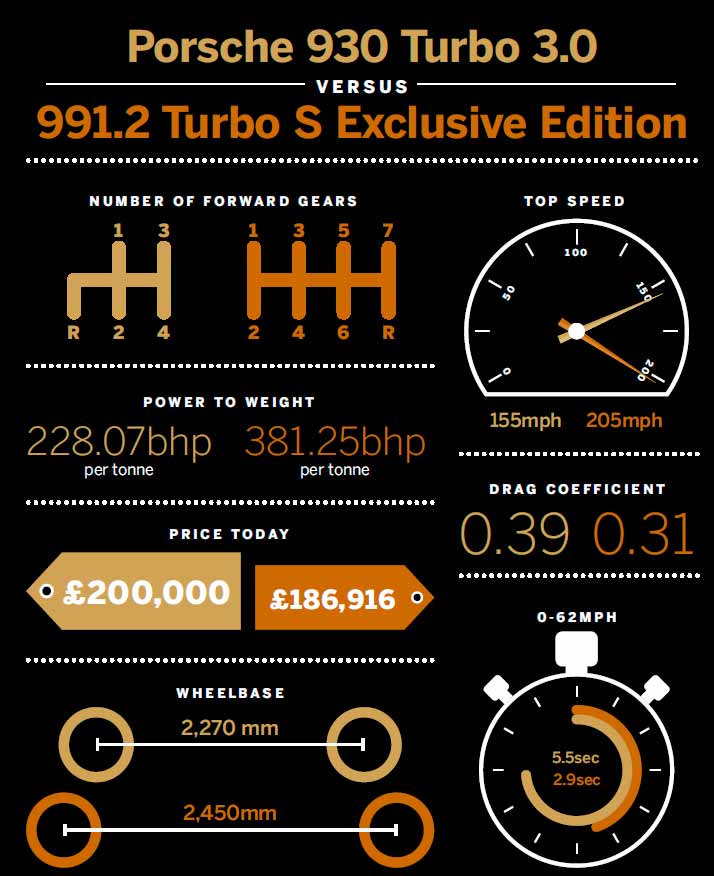
Turbo technology has advanced incomprehensibly in four decades. We drive two special 911 Turbos at opposite ends of Porsche development. Written by Neill Watson. Photography by Chris Wallbank.
EVOLUTION OF AS PECIES 930 vs. 991.2 Turbo S Exclusive Edition. Two truly golden 911s do battle as Porsche’s first Turbo is thrust against its modern rival.
“proof of the quantum leap in technology is in the drive”
RARE TURBOS 1976 930 3.0 versus 2018 991.2 Turbo S Exclusive Edition is the original Porsche Turbo DNA still present?

Second gear, just before the apex of the tightly radiused corner. Squeeze the power and wait for the 930 Turbo to spin up and deliver boost. 2,500rpm and nothing is happening. 3,000rpm and still nothing of significance. In fact, it’s feeling like a slightly flat, normally aspirated Porsche. Three-and-a-half grand and finally we’re feeling a shove between the shoulder blades, the boost gauge below the rev counter now stirring. Suddenly that softly sprung rear is squatting down and the nose is lifting, and we’re being pushed hard at the horizon. The revs rise at a disproportionate rate to what was happening a second ago and I’m readying for that long-throw 915 shift across the gate and into third gear, hoping that I can shift it briskly enough that the engine doesn’t fall of boost.

Ahead of us there’s a vivid, gold 991 Turbo S Exclusive Edition that only seconds ago was filling our windscreen and has now almost vanished over the horizon. The 930 Turbo, now on boost in third gear, is covering the ground rapidly, yet there’s just so much distance to make up. An awful lot has happened in Porsche technology in the last 40 or so years… and not only in turbocharging technology. In fact, today is proving to be such an education and reminder of automotive technology advancement that it’s going to take some time to gather my thoughts.
These two Porsche 911 Turbos are both utterly beautiful. The fact that they both happen to be shades of gold that reflect the prevailing fashions at the time of their production is a happy coincidence that makes for an attractive photoshoot here in North Wales. They are both equally stunning to behold, and of course both are rear-engined. However, beyond that the differences are so stark that they provide probably the most graphic illustration possible of how the Porsche 911 ethos of Darwinian evolution has brought us to what is probably the pinnacle of internal combustion engine technology today, without the addition of hybrid power. We have here the beginning of the Porsche Turbo and quite possibly the end, together on the demanding roads of the Evo Triangle.

I’ve driven the 991-generation Turbo before, so its performance is nothing new to me. It’s fair to say that I am a devoted fan of the 911 Turbo as a road car. I fully accept the argument that the GT3 line has a purity of throttle response that is linear and telepathic, yet there’s something about the effortless, devastating overtaking capability of the 911 Turbos of each respective generation that has given me many happy memories over my years of 911 driving. Most enthusiasts would admit that if there were only one Porsche to drive every single day for the rest of their life, it would probably be a 911 Turbo.
It’s for the best that I’m driving the 930 Turbo first. At least that way it stands a chance to impress with that charismatic, early generation power delivery. The nicely adjusted 915 shift has only four gears, and I’m reminded as a former 1979 Turbo owner just how often you use first gear around the town. Those junctions where you may normally dip the clutch a little and keep it rolling in second gear need a slow, deliberate shift down to first that ideally requires a little heel toe and timing to achieve smoothly; you’re using first as an actual gear here, rather than something you select once stationary. Leaving it in second can strand you mid-junction in a black hole of performance that can be a little embarrassing if you’re not careful.
The steering is unassisted and heavy, weighting up in the traditional 911 way as soon as the corners become significant. It’s not difficult – unless you’re trying a three-point turn in a side street – but it’s heavy nonetheless and gives your wrists a workout, with the steering wheel doing its unique 911 feedback dance over road imperfections. The ride is certainly firmer that a standard 911, though it’s far from hard.
Leaving the streets of Chester behind, it’s time to bring myself up to speed on the early 911 Turbo power delivery. Cruising on dual carriageways the long gearing makes for a relatively relaxed cruise, though if you’re at 70mph in fourth gear don’t expect significant acceleration without a downshift. Turning of the motorway to find the undulating A and B roads of North Wales, I’m reminded just how tricky it can be to make fast progress in an early 930 Turbo. In 1977 this was a groundbreaking car and, driven in the context of its time, its power advantage is massive. There is, however, a technique to getting the optimum performance from a four-speed 930 that can sometimes prove elusive. When you have a power-band that really only starts at 3,500rpm you could do with more options in the gearbox than the four tall ratios you’re given by Porsche. The story at the time was that the five-speed gearbox simply couldn’t take the torque, so the four-speed was the only option. So in many corners you’re creating a balancing act that mixes a combination of gear ratio, rpm and, crucially, boost.
Any open, medium-speed corner can offer the toughest choices. Take second: the rpm will be higher, right there where the boost begins. And because throttle position isn’t always an indication of power delivery, you’re constantly feeling for the boost coming in, feathering the throttle at the onset of that hiss as the turbo lag means you’re always trying to predict that sweet spot. Get it right and the 930 comes whistling and barking out of the corner, its rear squatting like a power lifter, front wheels feeling as if they’re only just touching the road. Get it wrong and you will be punished with either early mid-corner understeer as the front reaches for the sky, meaning a lift-of right when you really, really don’t want to, or those relatively modest rear tyres will break traction and then oversteer as they light up. In this instance you’ll need a quick pair of hands.
Indeed there are a great many things that are either missing entirely from the 1977 car or that have advanced so far as to be almost beyond comprehension. It takes a drive in the 991 Turbo S Exclusive Edition to bring that point fully home. Take the key as an illustration. The 930 Turbo key is just that: a key. It could almost be from any lock, anywhere. Never mind a car. The only clue is the beautifully weathered Porsche key fob. The Exclusive, meanwhile, has an exquisitely crafted item. It’s colour-keyed to the car’s hue and retracts snugly into its own leather garage when not in use. It’s a quality item that reinforces in your mind that your decision to spend £185,000 was the correct one. It barely resembles a key.
The ‘key’ clunks home into the socket as the car takes hold of it and comes to life. While this car is bristling with technology, I appreciate the fact that you start it with a simple turn of a key. No Italian supercar ceremonies of lifting up laps to dramatically thumb a big red ‘start’ button. I take a moment to find a comfortable seating position. For me, steering wheel reach and support under my thighs is a problem with older 911s. My giraffe-like body shape doesn’t lend itself to a non-adjustable steering wheel. In the Exclusive, 18-way adjustable electric sports seats, heated and ventilated, combined with a seamless electric steering adjustment for tilt and rake, makes me comfortable. The reassuring support under my legs and the nicely placed wheel confirms I could probably drive the length of Europe in this, all in one hit.
The steering wheel itself does far more than just turn the front wheels in today’s cars. In the same way that a helicopter pilot’s essential controls are placed close by his fingers and thumbs, once moving in a 991 Turbo there should be little reason to move your hands from the steering wheel for the entire length of the journey, such is the integration.
All of these things are, of course, very nice advancements in ergonomics. However, the proof of the quantum leap in technology is in the drive. Rolling forward from our photo location, the 991’s twin turbos are instantly responsive. Just moments in first, then a telepathic lick of your right fingers on the PDK paddle and second is delivered instantaneously, far faster than any human could manage. The car is now talking to the dampers, the engine and the gearbox. As the revs climb there’s absolutely no lag, simply a relentless, non-stop linear acceleration that shrinks the road ahead of you. The engine note hardens to a bark that makes it clear that this is definitely a 911 and there’s a fast, jet-like intake howl as the engine’s demand for ever more air ramps up. The brutality of the engine’s power delivery means that – for the first time ever – I am confronted with a car that I probably wouldn’t want as a manual shift… the choice of seven PDK gears seamlessly fires home and the end of the straight is reached. The carbon brakes bite hard and you realise that actually, after the thigh-pumping push to stop the 930 Turbo and load the front end up to turn in, we actually need to change down and drive up to the corner. Recalibration of braking distance complete, we press on over the undulating Welsh roads.
The more you drive the 991 Turbo S Exclusive Edition the more you become part of the car, in an almost cybernetic way. Straights are dispensed with as the engine and gearbox combination work harmoniously. As for the carbon brakes? If you have the confidence to be comfortable braking with your left foot from high speed there is a wonderfully tactile and precise way that you can enjoy bringing the speed down massively, yet then delicately carry that brake into the corner entry to nail down the front and then gently blend it with a throttle pickup that makes the transition between the two seamless and ever-so satisfying.
There’s no waiting for the front end to compress before braking hard, no concern about braking hard over those small bumps into a corner, nor having to think about the quality of your next downshift. No momentary concern about how the dampers are going to react as the weight comes back onto the springs after going light over that last crest. And yet, unlike other ‘supercar’ types, there’s never a suggestion that the car is taking over and doing everything for you. Together you’re a partnership that wishes to cover the entire length of a country, ideally without using motorways, in one hit.
So has the Turbo driving experience changed over the years? Yes. Massively. Does this mean that the 991.2 Turbo S Exclusive Edition isn’t really a 911 any more? Far from it. Despite its apparent physical size it actually occupies a similar-sized footprint to the 930 Turbo. And despite the modern technology dialling everything in and optimising the car continually, there’s no mistaking where the engine is positioned. You are certainly still driving a 911 Turbo. That Porsche skill at advancing the technology, making the car easy to drive and also retaining the feel and challenge of the original 911, is a truly remarkable feat for the 991.
Each car holds true to the silhouette of the Turbo shape. The wide rear arches of the 1977 car are instantly recognisable from posters on bedroom walls the world over, yet the modern, aerodynamic, CAD and wind tunnel-designed 991 Turbo Exclusive shape still holds true to the Turbo genre, still sporting rear arches that are unmistakably ‘Porsche Turbo’. The rear wing is more subdued today, though the 991 Turbo Exclusive is visually more lamboyant in other areas.
It’s also true that each Turbo still holds firm to the original ethos: to deliver a Grand Touring performance that enables the driver to cover ground effortlessly and be the most complete all rounder in the Porsche 911 product line-up of the time. Had I driven the 991 Turbo Exclusive in isolation I would doubtless have been impressed by its indomitable capabilities. By having the 930 here as a counterpoint it hammers home perfectly just how far we have advanced in the 40 years since the 930 Turbo was unveiled. Those intervening years have given that continuous development curve which means that we very often take for granted the capabilities of modern performance cars. To drive these two cars on the same roads on the day is a staggering education.
The 930 Turbo should be proud to sit alongside its descendent for the photoshoot. It laid the foundations and blazed the trail, creating what was a relatively blunt weapon that gradually evolved into the precision instrument that is the 2018 Porsche 991 Turbo S Exclusive 991.2. It’s been a remarkable journey.

| Model | Porsche 911 930 Turbo 3.0 | Porsche 911 991.2 Turbo Exclusive |
| Series | 930 | 991.2 |
| Year | 1977 | 2018 |
| Engine | Petrol Flat 6 | |
| Capacity | 2,994cc | 3,800cc |
| Compression ratio | 9.8:1 | 6.5:1 |
| Maximum power | 260bhp @ 5,500rpm | 607hp @ 6,750rpm |
| Maximum torque | 343Nm @ 4,000rpm | 750Nm @ 2,250-4,000rpm |
| Transmission | Four-speed manual | Seven-speed PDK |
| Suspension | ||
| Front | Torsion bar | MacPherson strut; PDCC |
| Rear | Torsion bar | Multi-link; PDCC |
| Wheels & tyres | ||
| Front | 7×15-inch; 185/70/VR15 | 9×20-inch; 245/35/ZR20 |
| Rear | 8×15-inch; 215/60/VR15 | 12×20-inch; 305/30/ZR20 |
| Dimensions | ||
| Length | 4,291mm | 4,507mm |
| Width | 1,775mm | 1,880mm |
| Weight | 1,140kg | 1,600kg |
| Performance | ||
| 0-62mph | 5.5 seconds | 2.9 seconds |
| Top speed | 155mph | 205mph |
THANKS The 930 in our pictures is for sale at Tech9. For more information visit tech9.ms or call +44 (0) 151 425 5911. Thanks to Howard from the CHC partnership for use of the 991
“There’s absolutely no lag, simply a relentless, non-stop linear acceleration that shrinks the road ahead of you”






